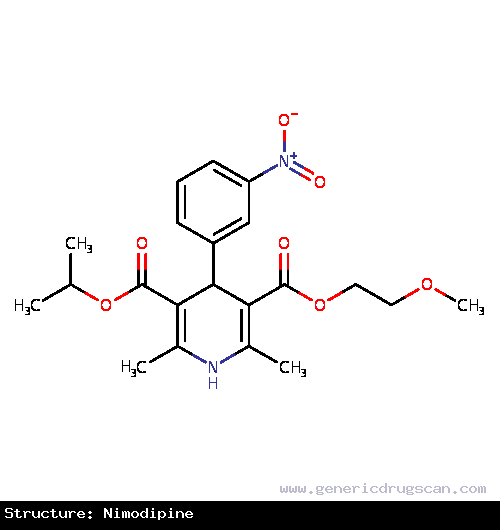Nimodipine Drug: Indication, Dosage, Precaution, Side Effect , Storage, Category Type and corresponding Brands - www.genericdrugscan.com
Nimodipine
Drug Status in USA : ApprovedDrug Status in Canada : Approved
pronunciation
pronounced as (nye moe' di peen)
Why is this medication prescribed?
Nimodipine is used to decrease brain damage that may be caused by a subarachnoid hemorrhage (bleeding in the space surrounding the brain that occurs when a weakened blood vessel in the brain bursts). Nimodipine is in a class of medications called calcium channel blockers. It works by relaxing blood vessels in the brain to allow more blood to flow to damaged areas.
How should this medicine be used?
Nimodipine comes as a capsule and an oral solution (liquid) to take by mouth or be given through a feeding tube. It is usually taken every 4 hours for 21 days in a row. Treatment with nimodipine should be started as soon as possible, no later than 96 hours after a subarachnoid hemorrhage occurs. Nimodipine should be taken on an empty stomach, at least 1 hour before a meal or 2 hours after a meal Follow the directions on your prescription label carefully, and ask your doctor or pharmacist to explain any part you do not understand. Take nimodipine exactly as directed. Do not take more or less of it or take it more often than prescribed by your doctor.
Swallow the capsules whole with water.
It is important to finish your entire course of treatment with nimodipine. Continue to take nimodipine even if you feel well. Do not stop taking nimodipine without talking to your doctor.
What are the precautions to be followed?
Before taking nimodipine,- tell your doctor and pharmacist if you are allergic to nimodipine, any other medications, or any of the ingredients in nimodipine capsules or oral solution. Ask your doctor or pharmacist for a list of the ingredients.
- tell your doctor or pharmacist if you are taking any of the following medications: certain antifungal medications including itraconazole (Onmel, Sporanox), ketoconazole (Nizoral), and voriconazole (Vfend); clarithromycin (Biaxin); certain medications for HIV including indinavir (Crixivan), nelfinavir (Viracept), ritonavir (Norvir, in Kaletra), and saquinavir (Invirase); nefazodone; and telithromycin (Ketek). Your doctor may tell you not to take nimodipine.
- tell your doctor and pharmacist what other prescription and nonprescription medications, nutritional supplements, and vitamins you are taking or plan to take. Be sure to mention any of the following: aprepitant (Emend); armodafinil (Nuvigil); alprazolam (Niravam, Xanax); amiodarone (Cordarone, Pacerone, Nexterone); atazanavir (Reyataz), bosentan (Tracleer); cimetidine (Tagamet); conivaptan (Vaprisol); cyclosporine (Gengraf, Neoral, Sandimmune); delavirdine (Rescriptor);diltiazem (Cardizem, Dilacor, Tiazac); dalfopristin/quinupristin combination (Synercid); efavirenz (Sustiva, in Atripla); erythromycin (E.E.S., E-Mycin); etravirine (Intelence); fluconazole (Diflucan); fluoxetine (Prozac, Sarafem, in Symbyax); isoniazid (in Rifater, in Rifamate); medications for high blood pressure or heart disease including diuretics ('water pills'): certain medications for hepatitis including boceprevir (Victrelis) and telaprevir (Incivek); certain medications for seizures including carbamazepine (Carbatrol, Equetro, Tegretol), phenobarbital (Luminal), and phenytoin (Dilantin); modafinil (Provigil); nafcillin (Nallpen); oral contraceptives (birth control pills); phosphodiesterase (PDE-5) inhibitors including sildenafil (Revatio, Viagra), tadalafil (Cialis), and vardenafil (Levitra, Staxyn); pioglitazone (Actos, in Actoplus Met, in Duetact, in Oseni); posaconazole (Noxafil);prednisone (Rayos); rifampin (Rifadin, Rifater, Rimactane, in Rifamate); rufinamide (Banzel); valproic acid (Depakene); verapamil (Calan, Covera, Tarka, Verelan); and vemurafenib (Zelburaf). Many other medications may also interact with nimodipine, so be sure to tell your doctor about all the medications that you are taking even if they do not appear on this list. Your doctor may need to change the doses of your medications or monitor you more carefully for side effects.
- tell your doctor what herbal products you are taking, especially Echinacea and St. John's wort.
- tell your doctor if you have or have ever had liver disease.
- tell your doctor if you are pregnant, plan to become pregnant, or are breast-feeding. If you become pregnant while taking nimodipine, call your doctor.
What are possible side effects of this medication ?
Nimodipine may cause side effects. Tell your doctor if any of these symptoms are severe or do not go away:- headache
- diarrhea
- nausea
- muscle pain
- rash
- dizziness
- lightheadedness
- slow or fast heartbeat
- swelling of the arms, hands, feet, or legs
How to store the medication and dispose it of after its use later?
Keep this medication in the container it came in, tightly closed, and out of reach of children. Store it at room temperature and away from light and excess heat and moisture (not in the bathroom). Throw away any medication that is outdated or no longer needed. Talk to your pharmacist about the proper disposal of your medication.
Drug Category/Class
- Dihydropyridine Derivatives
- Selective Calcium Channel Blockers With Mainly Vascular Effects
- Calcium Channel Blockers
- Vasodilator Agents
- Antihypertensive Agents
- Cardiovascular System
- CYP3A4 Inhibitors
- Dihydropyridine derivatives
| Prescribed | For use as an adjunct to improve neurologic outcome following subarachnoid hemorrhage (SAH) from ruptured intracranial berry aneurysms by reducing ... |
| Weight : | 418.4403 |
| Structure | Nimodipine |
 | |
| Formula | C21H26N2O7 |
Nimodipine has 9 Brands listed
| Caldip | Modipin (30 mg) |
| Modipin Inj (10 mg) | Nimocer (30 mg) |
| Nimodip (10 mg) | Nimodip (30 mg) |
| Nimotide (30 mg) | Vasotop (30 mg) |
| Vasotop (50 ml) |
Search Generic Drugs alphabetically
